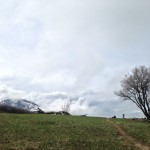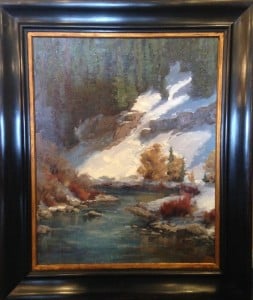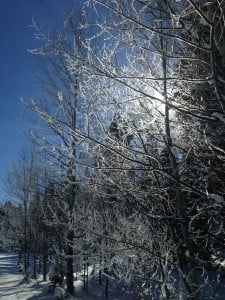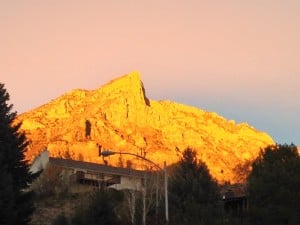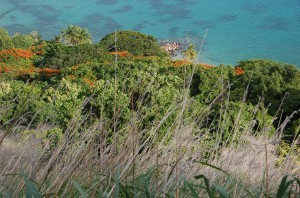 I think it is typical to imagine that there are two types of beauty—the natural beauty that the world offers as is and the invented, enhanced pleasures of art. The former is a kind of rawness that surprises us precisely because it does not seem to be made. It has no intention necessarily of being beautiful. It just is. In this category, we might think of the shape of Half Dome in Yosemite or the curvilinear red rock of The Wave in southern Utah. The latter more artificial beauty, of course, very much intends to catch the eye because it anticipates and solicits a viewer. It is constructed for such an encounter. In this category, we might think of something like Frank Lloyd Wright’s house, Falling Water, or Mont St. Michel.
I think it is typical to imagine that there are two types of beauty—the natural beauty that the world offers as is and the invented, enhanced pleasures of art. The former is a kind of rawness that surprises us precisely because it does not seem to be made. It has no intention necessarily of being beautiful. It just is. In this category, we might think of the shape of Half Dome in Yosemite or the curvilinear red rock of The Wave in southern Utah. The latter more artificial beauty, of course, very much intends to catch the eye because it anticipates and solicits a viewer. It is constructed for such an encounter. In this category, we might think of something like Frank Lloyd Wright’s house, Falling Water, or Mont St. Michel.
I invoke this contrast in order to dispel it. I remember when my oldest daughter was quite young and she was inquiring about the nature of art. What made something art, she wanted to know? When was something just “natural.” So we discussed objects like stones, trees, candy wrappers, and billboards, trying to see if we could understand when something was natural, when it was man-made, and when and why something might be considered to be beautiful or artful. Because of her persistent questioning, Eliza began to suspect that my examples didn’t measure up, that there was something false about the distinction itself.
We can hardly claim that we appreciate something like Yosemite Valley, for example, without having already anticipated the view, framing it in our minds with the help of so many Ansel Adams photographs and so many stereotypes of exotic or dramatic natural beauty. What with all of the animated films, CGI films, wall calendars, and the ubiquity now of images from the world’s greatest museums, we are so saturated with beautiful images that it might almost cause a yawn to finally see Half Dome in the flesh.
And yet, precisely because in our modern way of life we are so deprived of incarnate encounters with the world and are instead conditioned by myriad representations of what surrounds us, it would seem to be even more important that we seek to see things anew, even if it is only a fiction to pretend that it is for the first time. And it might especially pay to learn to see the magnificence in our own backyards.
I spent a great deal thinking about this question while reading the poetry of Walt Whitman, Pablo Neruda, and Derek Walcott. My readings led to my book, New World Poetics. I was struck by how insistent these poets were that the experience of newness was a fiction but that it was nevertheless a necessary fiction. The world is familiar and both the eyes we use to see it and the language we invoke to describe it are old and tired out, habituated by custom, to the point that we speak in clichés and scarcely see anything new at all. And the fact is that we cannot pretend to be able to shed habit, to speak another language or to see the world through a new set of eyes, even though this is precisely what art’s highest purpose is. Art offers a kind of makeover or a do-over, a rebooting of the imagination so that, even if for just a brief moment, we might catch a glimpse of something not yet seen. The paradox, of course, is that this experience is facilitated by the highest level of artificiality—artistic strategies of indirection, illusion, metaphor, and re-presentation of the world in order to wake us up, once and for all, to what it is we are living in this body, on this planet, at this moment.
I love a poem by Walcott, from his book White Egrets, in which he genuinely laments the fact that after almost 80 years of life, he still lives on a small Caribbean island where no opera house has been built, no major art museum, no theater. Each and every day what he faces is a raw, sun-drenched or rain-drenched world, still underdeveloped, still abused and underappreciated, still unblessed by the markers of culture. He can lament this, and he does, but he also understands that maybe away from the distractions of civilization (and of the internet, which he doesn’t mention perhaps because he has never faced its mesmerizing aura), he is more fortunate than unfortunate. This is because this world of his simple birthplace, despite the banalities of cruise ships and ugly government buildings, is still stunningly beautiful.
He writes:
…and yet there are the days
when every street corner rounds itself into
a sunlit surprise, a painting or a phrase,
canoes drawn up by the market, the harbours’s blue,
the barracks. So much to do still, all of it praise.
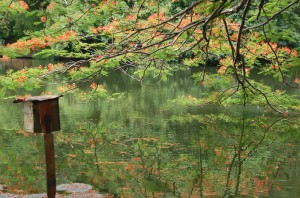 To praise the world. This is to see the world as new. But what, precisely, should we praise? And to whom? The great poet Rainer Maria Rilke said: “Praise this world to the Angel.” What did he mean? I think he meant that poetry is a language of praise for this world offered to the angels of the dead, those we imagine who have departed this world perhaps too early and perhaps tinged with a feeling of nostalgia or regret about how little they appreciated about the extraordinary qualities of this life. In other words, to awake from our slumber of habit, we must learn to imagine death, because if we can imagine the end of experience as we know it, then we can imagine the reasons for loving it beyond the grave, the reasons why it is always and forever strange and marvelous and beautiful and why the mundane, the ordinary, and the simple are not our poverty but our bounty.
To praise the world. This is to see the world as new. But what, precisely, should we praise? And to whom? The great poet Rainer Maria Rilke said: “Praise this world to the Angel.” What did he mean? I think he meant that poetry is a language of praise for this world offered to the angels of the dead, those we imagine who have departed this world perhaps too early and perhaps tinged with a feeling of nostalgia or regret about how little they appreciated about the extraordinary qualities of this life. In other words, to awake from our slumber of habit, we must learn to imagine death, because if we can imagine the end of experience as we know it, then we can imagine the reasons for loving it beyond the grave, the reasons why it is always and forever strange and marvelous and beautiful and why the mundane, the ordinary, and the simple are not our poverty but our bounty.


